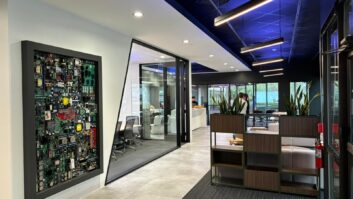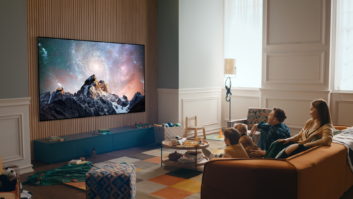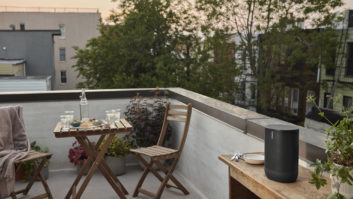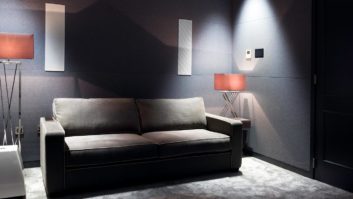Most custom A/V firms realize that to stand out requires the holy trinity of 1) superior design and technology, 2) exceeding client expectations and 3) keeping “the books” balanced.
As competition continues to grow, dealers are also seeing the need to differentiate their company from the flock.
One way dealers are distinguishing themselves is by diversifying services and products to offer clients more value on their investment. Lighting control is proving to be fertile territory in this regard. Dealers also have discovered that motorized-window treatments and IP-control can further enhance the value-advantage and “lifestyle” upgrade for a client.
“People are literally flocking to our Experience Center to learn about Lutron,” stated Melissa Andresko, Lutrons residential media relations leader, about the inflating interest in lighting control. Last year, the lighting manufacturer experienced an exponential increase in traffic through its Plantation, Florida, training center.
The Experience Center is currently open by invitation to designers, architects and other industry members curious about lighting control. It is available for “walk-in” customers seeking facility tours, and Lutron offers training sessions there for residential and commercial customers as well as courses for CEU accreditation. While the interest is swelling at the Experience Center, its not an isolated incident. Thousands of miles away, at the International Home Builders show in Las Vegas this winter, Andresko and her Lutron colleagues were rushed by dealers asking for advice on lighting control.
“The dealers approached me asking, How do I get started? I have homeowners asking me for lighting, but I dont really know anything about it, so, whats first?”
What is first? Opinions differ from person to person, company to company, but Andresko thinks the first step in the process is letting dealers experience, for themselves, what lighting is all about.
“Lighting control is, by nature, an experience,” Andresko said, “so the first stage in anyones pursuit of the technology is to experience first-hand what it is actually like. It is the same for dealers as it is for the homeowners. Once people see lighting control work, its obvious how it will enrich their life. And, show a client how lighting control will increase their sense of security, and they will wonder how they lived without it for so long.”
LiteTouch director of sales and marketing, Douglas Campbell, considers dealer training an essential element of the sales process. “Sales training and outreach is extremely important for us,” Campbell stated. “Once a month we offer training for our dealers on products and installation. Once per quarter we also offer a specific sales training course. Potential homeowners and clients both need to become familiar with the vernacular of lighting control; its features and benefits are romantic and emotional, but also practical. We encourage our dealers to emphasize the romantic elements of lighting such as moods and scenes. Dimming levels that create some nice moods, exterior scenes that accentuate landscaping…these elements enhance the aesthetics of a residence and enrich the life experience.”
Jeff Zemanek, Lutrons national sales manager of residential systems, concurred. Zemanek also pointed out some of the ways Lutron supports dealers and helps them understand the lighting control experience so that they can articulately convey it to clients.
“Lutron offers a program called the HomeWorks Road Show Training; its geared for our HomeWorks dealers so they can stay up to date on the latest and greatest products, as well as any changes to the product line,” he said. The very first day of the program offers participants a seminar and pertinent discussion, called “The Art of Selling Lighting Controls.”
For dealers without showrooms, manufacturers offer a couple of suggestions. First, Lutrons Experience Center is always open for business. So dealers in the Florida area are encouraged to stop in and bring clients or architects. Second, Lutron offers a handy mobile demo tool thats the size and style of a childs dollhouse. The dollhouse lights and scenes activate in the same manner as a fully automated million-dollar mansion. While novel and eye-catching, the mobile tool is valuable for dealers who dont have their retail facilities outfitted with lighting control, and clients who need to physically see something before they can discuss buying it.
For “hard-sell” clients, focusing on window-treatments is a tactical way to peek interest in lighting control, and perhaps close customers. “When you start talking about scenes and pathways to a homeowner, their eyes sometimes start to gloss over,” Zemanek stated. “But if you talk about electronic-driven shades and drapes, they can walk up to their window and know exactly what you are talking about.”
Because shades and draperies, in their baroque opulence or monastic minimalism, are a part of our daily lives, it makes sense to use them as a bridge to help homeowners understand how an automated system will enhance the day-to-day.
Motorized-window treatments can also add value to a home by protecting expensive artwork, furniture and rugs from detrimental UV light. Especially for homes in the sun-rich areas of Southern California, Arizona and New Mexico, customized control of light exposure is essential.
Once dealers establish the importance of protecting their clients domicile via window treatments, its easy to sell the rest of the lighting system, mainly because its free. “Because you need the processor to automate window treatments,” Zemanek stated, “dealers need to simply add the dimmers and keypads necessary to complete the system and you have a total lighting control solution for your house.”
Another focal point when selling the lighting control experience is security. If, when decrypting the secrets of The Da Vinci Code, someone hears an unfamiliar noise, he or she can turn on all the lights in the house with the touch of one button. Additionally, because lighting control can be tied into alarm systems, if a fire alarm is set off, the contiguous lighting control will activate pathways leading a family on their speedy exit to safety outside.
Value is yet another aspect dealers should enthusiastically articulate with clients to sell the lighting control experience. With the stability of utilities markets rivaling that of the San Andreas Fault, it doesnt hurt to have control over the frequency of electricity usewhich lights go on, and when.
There are other aspects of the category that make lighting control easy to sell itself. When illustrated properly, the convenience factor can be compelling for homeowners. “One-button” access is the king wow factor, so it helps early on to give clients the full convenience experience.
The way lighting is intuitively addressed in LightSource by Crestron, for example, homeowners will realize that far from being complex, its actually fun. Crestrons new lighting solution offers not only the requisite dimmers and wall panels, but also seamless integration with its robust residential controllers and IP access.
Also offering new IP-based solutions for lighting is the Salt Lake City, Utah manufacturer, LiteTouch. LiteTouch just came out with a new ethernet-enabled processor. “Its the brain of the system which allows control and customization of lighting via a local area network,” stated LiteTouchs Greg Giauque. The flexible communications card-based system makes it easy for installers to expand coverage and control.
“Since the system is IP-addressable, our dealer can plug into a network and access our processor from anywhere and make programming changes,” LiteTouchs Douglas Campbell added. “This also gives homeowners confidence. They know that with this technology, if they have an issuewhether its an emergency or simple maintenancethe dealer can do the work from a remote location.”
Lightolier Controls is another technology manufacturer that wants to redefine lighting control to make it easier to install and simpler for homeowners to use. Its Compose PLC Convertible dimmer and the Compose PLC Fan Control were launched earlier this year with flexible operation and user-friendly features.
Aesthetics and architectural integrity are also critical to selling lighting control. When comparing three million-dollar homes, features and amenities may vary, from countertops to showerheads to home theater setups. What most every million-dollar house will have in common, however, is a numbingly conventional 150-year old light-switch design. That there simply is something better than what were accustomed to is a new concept, but an easy paradigm shift. Savvy dealers simply have to know how to express it.
The marketing campaign of the StJohn Group, the high-end custom technology manufacturer and distributor, distills this point to its essence. StJohn asks: “What adds to both the style and function of home theater environments? The answer should be obviouslighting.”
StJohn Group is now offering dealers Matthews Studio EquipmentHollywoods signature grip company products, including classic architectural lights designed for home theater environments. Available in diverse finishes and with lens and filter options, all are hand-finished and designed to compliment the interior. Custom finishes are also available.
Vantage, the Orem, Utah, lighting and control manufacturer, is also emphasizing elegance with its new suit of sleek faceplates. Vantage also expects to ship its new line of BriteTouch buttons in the third quarter of 2004 to provide automation and lighting control for all styles. The buttons allow unlimited colors, at any brightness, with personalized icons or fonts, without the need for factory engraving. A Vantage keypad can accommodate up to eight BriteTouch buttons.
And dealers seem to appreciate the diverse options available to them. According to Ty Meyer, president of Audio Video Design in San Juan Capistrano, California, lighting control was something he didnt consider offering before because it was too complex. “Before, the options werent comprehensive,” Meyer stated. “Now, Lutron has created their HomeWorks program which is very different from the old Radio RA. Once I saw HomeWorks in action and realized that it was all based on logic, I knew it would be so much better to work with. HomeWorks is also great because you can scale it, making it work with as many or few zones as you want.”
Meyer and his team now view lighting control as an excellent value-added service to offer clients, and plan on integrating Lutron systems into future projects.
Margot Douaihy is managing editor of Residential Systems.







